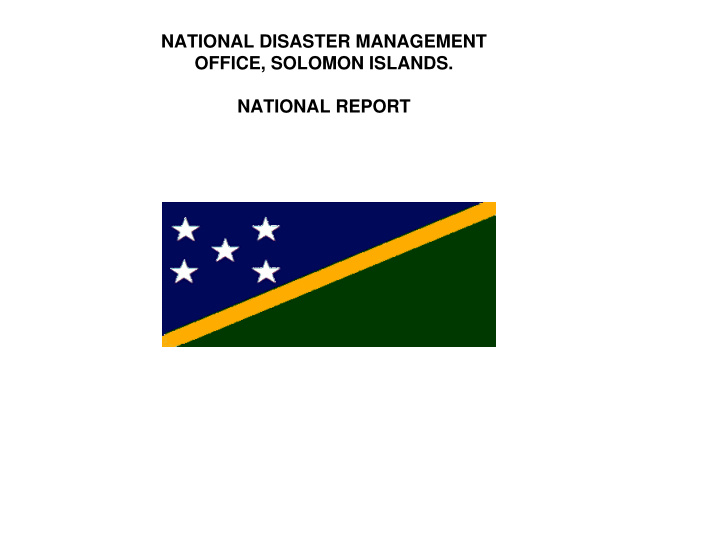



NATIONAL DISASTER MANAGEMENT OFFICE, SOLOMON ISLANDS. NATIONAL REPORT
INTRODUCTION • General Information of Solomon Islands • Natural Disasters • Organizational Chart • Status of Hyogo Framework for Action Implementation.
General Information. Solomon Islands is a developing island nation with a population of approximately 400,000 people. The country is located in the South Pacific Region between 155. 30 and 170.30 E longitude and between 5.10 and 12.45 S latitude.
Continue • The country’s main ethnic group is Melanesian, making up close to 93%, and the balance is Polynesians 4%, Micronesians and others 1.5%. The country consists of 992 islands, scattered over 1.35 million sq km of sea. About 350 of the islands are populated.
Continue • The Solomon Islands is prone to a lot of threats and risks. Natural disasters are a serious threat to the country, and there is a wide range of other hazards, both natural and man-made. • These threats include cyclones, landslides, floods, earthquake, volcanoes and tsunami. Other hazards and risks include fire, civil unrest, epidemic and rapid population growth.
Regional Location • Sits on the Pacific “Ring of Fire”. • Sits on the subduction zone of two tectonic plates and subjected to frequent earthquakes. • Sits on the Pacific cyclonic belt. • Sits within 1.32 million km2 of an Ocean waters • Covers a land mass of 30,000 km2
ORGANISATIONAL STRUCTURE NATIONAL DISASTER ORGANISATION OF THE SOLOMON ISLANDS
Minister for Home Affairs National Disaster Council Risk Reduction Emergency Recovery and Operations & Preparedness Coordination Technical Advisory Team Government See next slide Departments/ NGOs Government Departments/ Provincial NGOs Disaster Committees Provincial Disaster Committees
Minister for Home Affairs National Disaster Council Risk Reduction Emergency Operations & Recovery and Coordination Preparedness Central Control Group National Emergency Operations Centre Government Departments, NGOs and DM agencies Provincial Disaster Committees
Organisational Structure • Minister Responsible – Home Affairs Ministry. • National Disaster Council – Chairman, Permanent Secretary, Ministry of Home Affairs
Roles & responsibility of the NDC – section 8 of the NDC act 1989 • Advice Minister on matters relating to disasters. • Approve & coordinate preparedness, response and recovery activities. • Assume full and complete control in operations connected with disasters. • Provide and render financial assistances to committees ..
National Disaster Management Office - NDMO • Established by section 7 of the NDC Act 1989. • Reports direct to the Chairman – NDC • Director – Secretary to NDC • Current staffing – 17 established staff – Driver /Security – Office Aid
Functions • Specified under Section 8 of NDC Act 1989. – Responsible to the council in the administration of the NDC Act 1989 and other relevant plans which relate to disaster management. – Review & update of the National Disaster Plan – Keep & maintain proper accounts and register of NDC assets. – Prepare annual reports or bulletins as directed by NDC. – Ensuring Provinces are in a state of readiness to execute disaster plans if need to. – To perform other functions that may be assigned by the council. – The above functions of the NDMO is further defined into specific responsibilities in ANNEX M of the NDP - 1987
Status of HFA Implementation Although Solomon Islands have not yet have a National Action Plan that targets the HFA’s five priority areas, NDMO at the National level have conducted activities and initiatives to in regards to the 5 thematic areas.
Status of HFA Implementation Priority 1: Law, Institutional Framework, National Plan. • NDMO has taken the initiative to review the National Legislation on Disaster Risk Reduction and supporting legislations. • Work plan priority is the review of the 1987 National Disaster plan and 1989 National Disaster Act which has never been reviewed
Status of HFA Implementation PRIORITY 2: Risk Analysis and Early Warning • Little have been done on the implementation of risk analysis and early warning systems in the country. • New initiative of conducting a Gap Analysis by the World Bank this year. • National Tsunami Capacity Assessment Workshop 5 – 8 February 2008.
Status of HFA Implementation PRIORITY 3: Disaster Education • On going public awareness and education campaigns at the national, provincial and community levels, through media ( national radio and newspapers) • Initiative to integrate disaster risk reduction in the country’s school curriculum.
Status of HFA Implementation PRIORITY 4: Loss prevention activities • Loss prevention activities such as building codes rests with the Ministry of Infrastructure, but are not properly monitored and police. • More work needs to be done in this area from responsible authorities such as the town and country planning division.
Status of HFA Implementation PRIORITY 5:Disaster Preparedness • Recruitment and training of 10 Provincial Disaster Coordinators as full time disaster managers at the Provincial Level. • Training of Disaster Managers in Emergency Operation Centre and Exercise Management courses. • Conduct Emergency Operation Centre exercise with government agencies and stakeholders.
Status of HFA Implementation PRIORITY 5 con’t: Disaster Preparedness • Conduction of a National Exercise by NDMO and stakeholders to test out NDMO Standard Operating Procedures
Recommend
More recommend